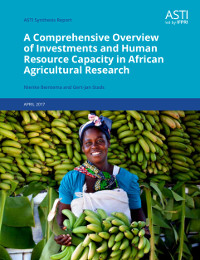A Comprehensive Overview of investments and Human Resource Capacity in African Agricultural Research.
Nienke Beintema and Gert-Jan Stads
International Food Policy Research Institute.
Nienke Beintema and Gert-Jan Stads
International Food Policy Research Institute.
April 2017, 56 pages
Countries in Africa south of the Sahara (SSA) have made progress increasing their investments to agriculture, honoring regionwide commitments such as CAADP. However, new data and analysis by Agricultural Science and Technology Indicators (ASTI) shows that growth in agricultural research investments has lagged considerably behind spending on other agricultural areas, such as farm support, subsidies, and irrigation.
These findings—along with datasets, analysis, country factsheets, and online tools for country comparison, graphing, and benchmarking—have been just released online and summarized in a newly released ASTI Synthesis Report,
The data cover key indicators on agricultural research investments, human resource capacity, and research outputs in the region. Other highlights include:
These findings—along with datasets, analysis, country factsheets, and online tools for country comparison, graphing, and benchmarking—have been just released online and summarized in a newly released ASTI Synthesis Report,
The data cover key indicators on agricultural research investments, human resource capacity, and research outputs in the region. Other highlights include:
- As of 2014, half the region’s PhD-qualified agricultural researchers were in their 50s and 60s, thus reaching retirement age. Training and capacity building is needed to avoid capacity gaps that could jeopardize future research outputs.
- Compared to other regions around the world, agricultural research in Africa remains highly dependent on volatile donor funding. National-level decision makers must diversify funding sources.
- New ASTI analysis of national spending targets based on characteristics of each country’s economy and agricultural sector show a considerable gap between what countries are—and realistically could be—spending on agricultural research.


No comments:
Post a Comment